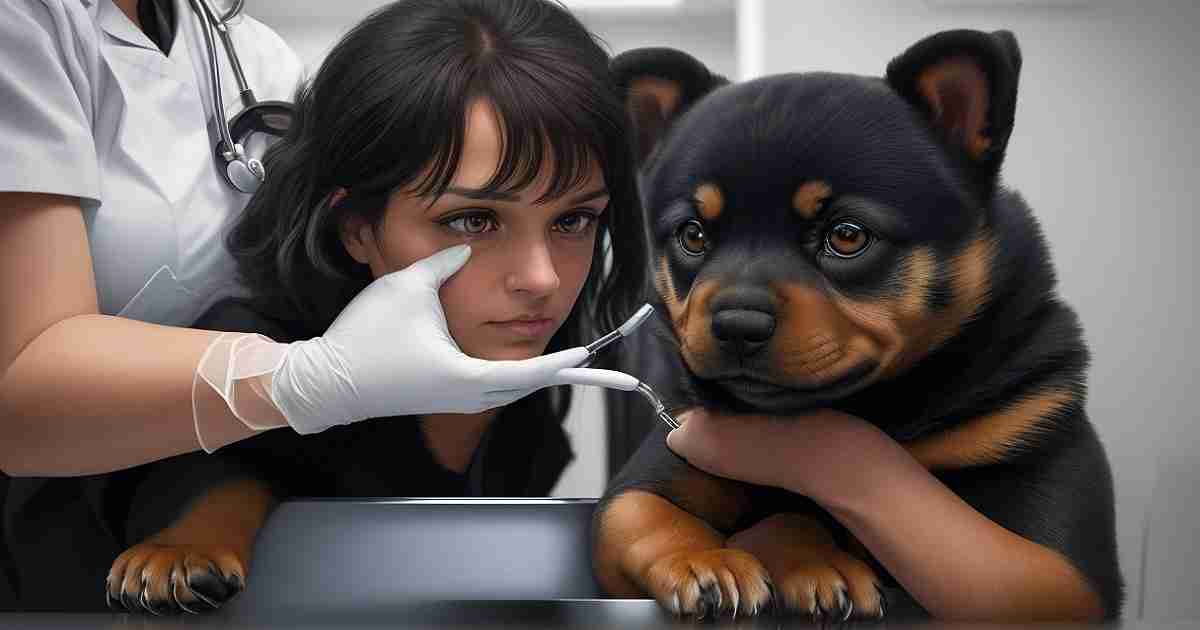Rottweiler Tail Docking
Tail docking is the partial removal of a dog’s tail, typically performed on newborn puppies between 3-5 days old. The procedure has historically been commonly performed on certain breeds like Rottweilers to conform to breed standards regarding tail length.
Rottweiler tail docking has origins tracing back to the Roman Empire, when dogs would accompany the Roman legions and their tails were docked to prevent injury.
When the Rottweiler breed was established in Germany in the 19th century, tail docking was continued based on both tradition and the belief that it prevented tail injuries as the dogs herded livestock.
Here are some of the most common motivations for docking a Rottweiler’s tail:
- Conforming to breed standards and aesthetics. The American Kennel Club standard calls for a docked tail no longer than 2 inches on a Rottweiler.
- Preventing tail injuries. Historic belief that docking protects working dogs from injuring tails.
- Hygiene purposes. Docked tails can reduce risk of infection and keep the rear clean.
- Ease of identification. Distinguishes Rottweilers from other breeds.
Tail docking procedures today are typically performed by veterinarians using surgical amputation or banding methods. The tails are docked fairly short, leaving just 1-2 vertebrae.
However, Rottweiler tail docking remains controversial today due to animal welfare concerns. Critics view the practice as unnecessary cosmetic surgery, as few Rottweilers still serve as working livestock herders.
Here are some of the main ethical concerns regarding docking puppy tails:
- Pain and stress caused by docking.
- Risk of complications and infection.
- Permanent loss of communication from tail.
- Violation of dogs’ natural state.
Tail docking bans have been passed in many parts of Europe, Australia and elsewhere. But the practice remains common in the US. The American Veterinary Medical Association opposes docking for cosmetic purposes but still permits it in compliance with breed standards.
So while deeply ingrained in tradition, Rottweiler tail docking continues to spark intense debate between show breeders, working dog proponents, veterinary associations and animal welfare advocates.
Methods of Rottweiler Tail Docking
So you’ve decided to dock your Rottweiler puppy’s tail. Let’s dive into the actual tail docking procedures and techniques used by vets and breeders.
Now I wanna be upfront – this stuff makes some folks squeamish. But it’s important to understand exactly what’s involved so you can make an informed decision for your pup. OK, let’s get into it!
Natural Tail Docking
There are a couple ways to dock those tails naturally without too much intervention from humans. Here’s how it works:
- Rubber band docking – A tight rubber band is placed around the tail to restrict blood flow. The tail eventually drops off due to lack of blood circulation.
- Cut and tear method – The tail is cut and the skin torn a bit to expose the bone. As the bone dies off, the tail detaches.
Obviously these methods cause some level of pain and stress. Many vets advise against natural home docking techniques for welfare reasons. But it does avoid surgery.
Surgical Tail Docking
This is the standard medical procedure done by most vets these days. Tail docking surgery involves fully amputating the tail with surgical tools and techniques.
The main methods used:
- Cutting with scalpel – A sterile scalpel is used to cleanly cut through the tissue, muscle, nerves and bone to remove the tail.
- Electrocautery – Electric current burns through the tail to sever it. Cauterizes the wound to limit bleeding.
The surgery is done fast – usually 1-2 minutes total. Vets often don’t use anesthesia since it poses risks to young puppies.
Typical Docked Tail Lengths
So how short are we talking here? Good question.
For Rottweilers, a “natural bobtail” look is desired. That means leaving just 1-2 vertebrae on the tail:
- 1 vertebra = Tail of 1.5 – 2.5 cm
- 2 vertebrae = Tail of 2.5 – 5 cm
This gives the signature super short nub that conforms to the breed standard. Some vets advise leaving 2 vertebrae to better support tail muscles.
Docking Styles
There are a few options when it comes to final docked tail shapes:
- Straight dock – A blunt, straight cut.
- Round dock – Rounded, blunt tip. Achieved by shorter cut and stitching.
- Split dock – Vertical incision is made on the last vertebrae before docking. Gives natural rosebud tip.
The split dock style retains a bit more tail function for muscle control and communication. But any docking reduces overall tail expressiveness.
Recovery and Aftercare
Helping that little nub heal up proper is so important for health and hygiene. Here are some crucial docked tail aftercare tips:
- Check bandage daily and keep clean. Monitor for infection.
- Restrict activity to allow healing for 7-10 days.
- Apply antibiotic ointment daily for 7 days.
- Soft, bland diet helps avoid gastrointestinal issues.
- Prevent chewing, licking or abrasion of the tail.
- Ensure proper sanitation during bathroom time.
Proper aftercare is vital since the shortened tail and open wound are prone to infection. Follow your vet’s advice closely!
And there you have it! As you can see, there are definite risks and rewards with Rottweiler tail docking. Make sure you think through the decision fully before taking the leap. But with careful surgery and aftercare, you can achieve that desirable short tail for your pup.
Let me know if you have any other tail docking questions! Happy to chat more about this fascinating and controversial slice of dogdom.
Preparing Your Rottweiler Puppy for Tail Docking
Your precious Rottie pup is going for the chop! Let’s make sure the little fuzzball is ready for the tail docking procedure. Proper preparation will help ensure good health and minimize risks.
Physical Health and Exams
Vets will perform a full physical exam before tail docking to check for any issues. But you can get a head start on peeking at your pup’s health:
- Shiny coat, clear eyes and nose – Signs of good health.
- Watch weight and growth. Should gain around 10% per week.
- Look in ears, mouth for any signs of infection.
- Feel abdomen – it should be soft. Hard bellies can indicate worms.
- Check heart and lungs with stethoscope. Should be clear.
Bring any concerns to your vet before the procedure date.
Vaccinations
Like going off to doggy college, tail docking requires certain immunization records!
Make sure your puppy’s shots are up to date:
- Parvovirus – A deadly threat for puppies.
- Distemper – Highly contagious virus.
- Adenovirus – Liver disease risks.
- Parainfluenza – Respiratory infection.
- Bordetella bronchiseptica – Severe kennel cough.
Diet and Nutrition
Proper nutrition provides energy for healing. Follow these tail docking diet tips:
- High-quality puppy food – Supports bone growth and immune system.
- Digestible carbs – Whole grains and minimal sugars/fats. Avoid upset stomach.
- Lean protein sources – Fish, chicken, turkey, eggs. Supports tissue repair.
- Vitamin supplements – Discuss with your vet. Vitamin K aids blood clotting.
Keep an eye out for vomiting, diarrhea, appetite changes before and after the procedure.
With careful prep, your pup will sail through tail docking fixed up with a cute curly cue. Stay tuned for more tail docking tips and info!
Finding a Qualified Vet for Rottweiler Tail Docking
Choosing the right vet to dock your Rottweiler puppy’s tail is super important for health and safety. Let’s explore some tips on identifying qualified tail docking vets!
Experience and Expertise
Look for an experienced vet that specializes in docking puppy tails.
✅ Ask about their background:
- How many tail docking procedures have they performed?
- Do they have training on latest techniques?
- How many years have they been practicing?
✅ Look for Rottweiler expertise:
- Do they have experience with the breed?
- Are they familiar with breed standards for docked tails?
- Can they advise on risks specific to Rottweilers?
Choose knowledge and competence over convenience – it’s worth the drive!
Proper Licensing
Ensure your vet is properly licensed and certified:
- 🩺 Graduated from an accredited veterinary school
- 🩺 Valid state license to practice
- 🩺 Member of the American Veterinary Medical Association (AVMA)
Also confirm the clinic itself is accredited and outfitted for surgeries.
Vet References
Get trusted opinions on vets:
- 🐕 Ask your breeder for recommendations
- 🐕 Check Rottweiler owner forums and groups
- 🐕 Read online reviews of the vet’s tail docking services
- 🐕 Ask to contact previous clients about their experiences
Quality vet referrals help you make the best choice.
By finding an experienced, licensed vet with glowing reviews, you can ensure your Rottweiler puppy gets top-notch tail docking care. Stay tuned for more tips on this important procedure for your beloved pup!
Laws and Regulations Around Rottweiler Tail Docking
Before docking your pup’s tail, it’s crucial to understand the legal landscape. Tail docking laws vary greatly depending on where you live.
United States
- No nationwide ban; rules differ by state.
- Generally permitted for working dogs like Rottweilers.
- Must be performed by licensed vet.
- Banned for cosmetic purposes in CA, MD, NJ, NY, PA.
Canada
- Banned nationally for cosmetic purposes.
- Permit required for Rottweilers used in law enforcement.
United Kingdom
- Tail docking banned entirely for cosmetic reasons since 2006.
- Only permitted for working dogs under strictly defined conditions.
Europe
- Tail docking banned in most EU countries including Germany, Switzerland, Austria.
- Still legal in Ireland and Finland.
Australia
- Tail docking banned across most states and territories.
- Remains legal in some rural regions.
As you can see, tail docking regulations are rapidly evolving worldwide. Be sure to fully understand your local laws before proceeding. Your vet should advise you on legal docking for your Rottweiler puppy. Stay tuned for more tail docking tips and facts!
Alternatives to Docking a Rottweiler’s Tail
While historically common, tail docking remains controversial today. Many owners now opt to keep their Rottie’s tail natural. Let’s explore some alternatives!
Keep That Wagger!
More owners are embracing the natural Rottweiler tail:
- ✔️ No surgical risks or pain.
- ✔️ Retains tail communication and function.
- ✔️ Conforms with anti-docking laws.
- ✔️ Still commands that bold Rottweiler look!
If you want to preserve your pup’s tail, stand proud! The choice is yours.
Corrective Surgeries
For serious tail injuries or health issues, corrective surgery can help while preserving most of the tail:
- 🩺 Partial amputation – Removal of damaged vertebrae/tissue.
- 🩺 Tail straightening – For limber tail syndrome.
- 🩺 Set tail fractures – Use pins and splints.
- 🩺 Tumor removal – Apply radiation or chemo as needed.
Talk to your vet about surgical options if your pup has a problematic tail. No need to dock the whole thing!
Training and Habits
Prevent injury and issues by establishing healthy habits:
- 🐶 Relaxed posture – Discourage excessive tail wagging.
- 🐶️ Gentle handling – Don’t pull on tail excessively.
- 🐶 Proper exercise – Helps strengthen tail muscles.
- 🐶️ Safety proofing – Pad sharp furniture, use soft crates.
With proper care and training, your Rottweiler can keep the tail nature intended!
While tail docking still has its advocates, alternatives let you preserve your Rottweiler’s natural state. Talk to your vet and breeder about the best options for your pup!
Frequently Asked Questions About Docking a Rottweiler Puppy’s Tail
Let’s tackle some common questions on Rottweiler tail docking from worried owners:
How old should a Rottweiler puppy be for tail docking?
- The prime age is 3-5 days old.
- Nerves are less developed so procedure causes less pain.
- Tail vertebrae are still soft, making docking easier.
- Wound heals quickly at this young age.
Don’t wait too long or the procedure becomes more problematic!
What methods are best for minimizing pain?
To reduce discomfort:
- Use banding rather than cutting if possible.
- Opt for shorter surgery time.
- Avoid anesthesia which stresses young puppies.
- Use topical anesthetics on wound after.
- Give post-op pain meds as needed.
Proper technique and aftercare make a big difference!
How much does tail docking usually cost?
Expect to pay:
- $30 – $50 for banding.
- $50 – $300 for surgical docking.
- More for anesthesia or tail straightening.
Prices vary by clinic, location and technique. Talk billing before booking!
What aftercare is needed post-procedure?
Crucial aftercare tips:
- Check bandage and change daily.
- Limit activity for 7-10 days.
- Apply antibiotic ointment for 7 days.
- Soft diet and rectal stimulation.
- Prevent tail chewing/biting.
Don’t slack on aftercare – proper healing is vital!
Still have questions on docking your Rottweiler puppy’s tail? Just ask! Let’s get that little nub healed up perfectly.







